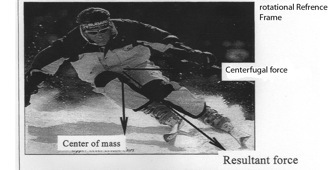Ski Design
The modern parabolic alpine ski has come a long way performance wise from its straight ancestor. In order to achieve this ski engineers have relied upon concepts of rotational motion, kinematics,
1.) When attempting to carve a turn a skier is in dynamic equilibrium.
2.) This is when the skier undergoes rotational motion. To balance the forces of centripetal acceleration the skier must bring the center of mass inside of the radius of the turn, in order to not crash and die.

3.) This is where the Parabolic ski comes into play. In a carving situation the skier must change the direction of his or her momentum.
4.) To do this the inner edge of the ski is pressed into the snow. The amount it must be pressed into the snow is significantly greater in a parabolic ski.
Disclaimer: The centrifugal force is a pseudo force used in an rotational reference frame that any observations are made.
Pic from Materials and Science in Sports




Force of friction when carving
Force which turns ultimately the ski into the carve
Vs.
5.) When the parabolic ski is up on its edge it has a lot of reverse camber. Therefore the skis greater frictional forces force it into a larger radius circular arc.







Force which turns ultimately the ski into the carve
Force of friction when carving
6.) The straight ski has less reversed camber agianst the snow surface when it is on its edge, therefore its frictional forces force it into a larger radius circular arc.
Pic from The Effect of Sidecut Radius on the Dynamics of Alpine Skiing
